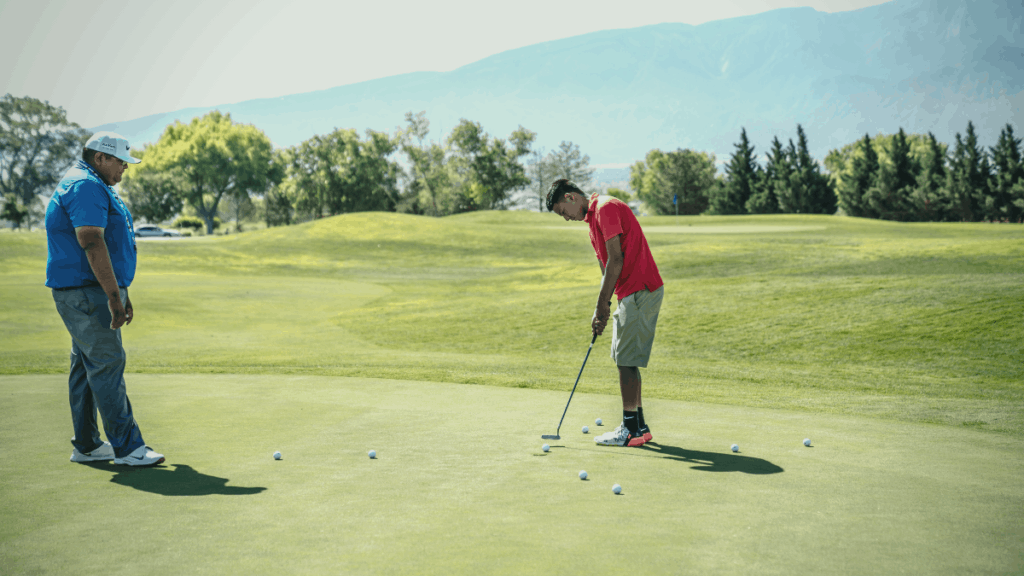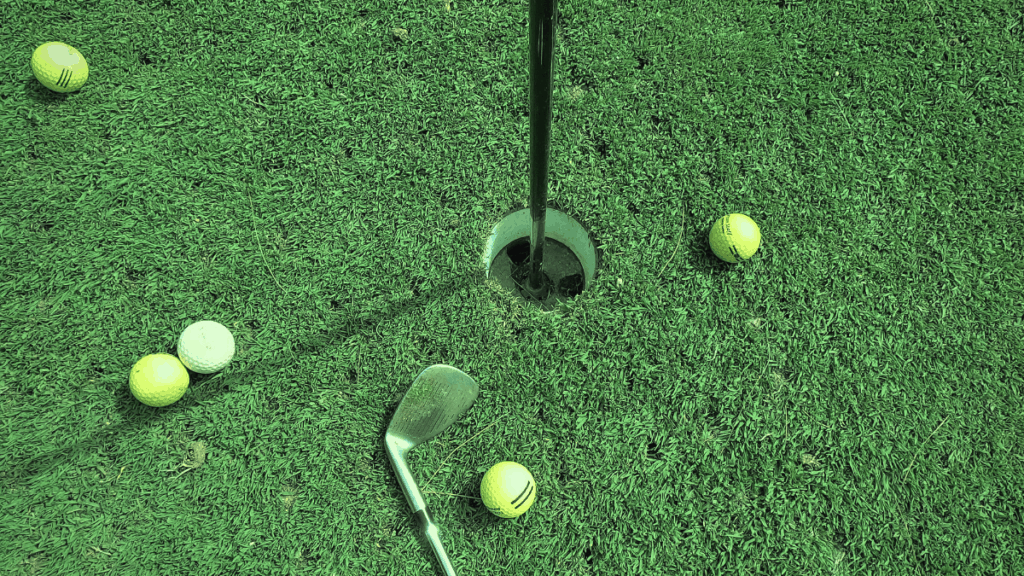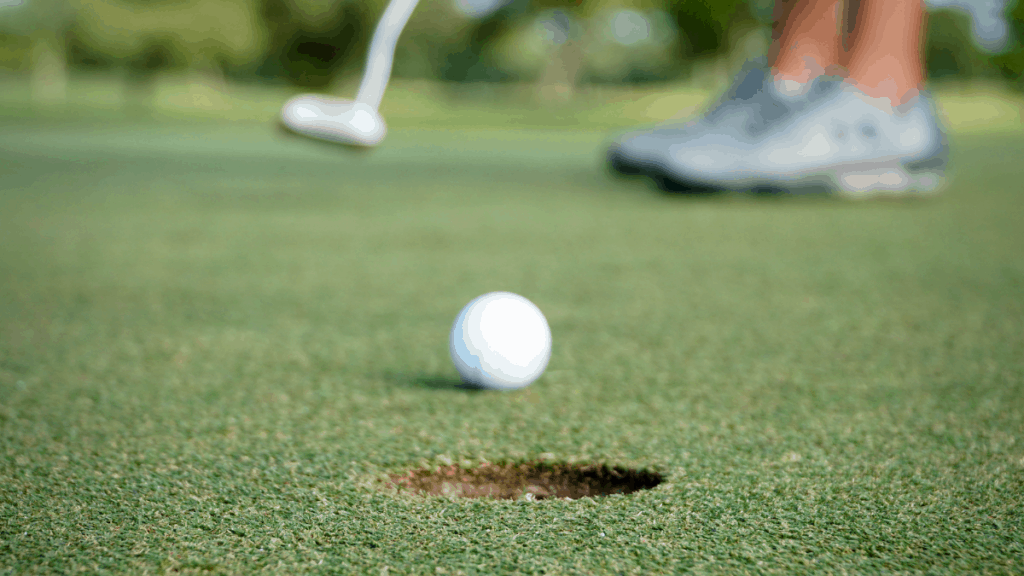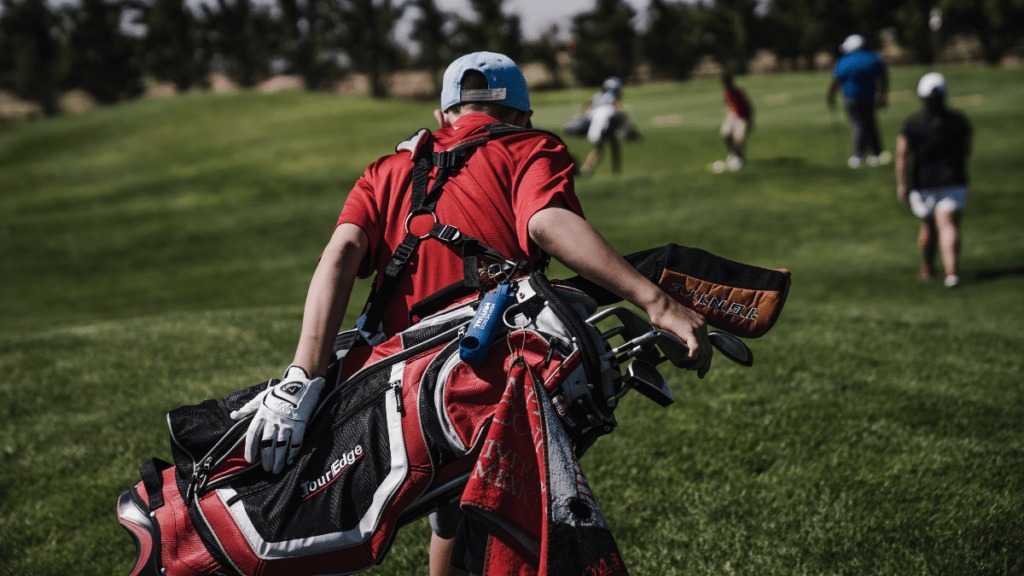The great Arnold Palmer spoke these words once,
“Golf is deceptively simple and endlessly complicated.”
Anyone who has played a few rounds of this popular sport knows this quote is as accurate as they come.
The basics of this game on the green are quickly learned, and a passion for the sport can be formed in only a few holes of play.
However, becoming truly astounding at the game is a much harder card to play. The good news is, it’s not impossible.
The following five sets of drills, tips, and information will have you shaving strokes off of your game and improving more quickly than you might have dreamed.
Practice, practice, and more practice
Getting out there and hitting some balls is the biggest way to improve your skill. The more hours you put into the game, the more you can hone technique and playstyle.
The problem is that just practicing without a goal or plan isn’t quite as useful as going out there with knowledge and goals.
According to experts, there are four laws of sound practice (golf.com). Learning to utilize each of these in your practice will make it much less frustrating.
Even when things aren’t going your way, there’s a flow that can hit you that makes you a better player. So make sure you’re out there practicing as much as you can.

Personalized Practice
The laws of golfing, according to the mentioned article, begin with an easy concept. All practice should be personalized to the player. It seems like something that would be common sense, but it can be a bit more complicated.
By personalizing your practice, you are putting yourself out of your comfort zone. If you have a golf coach or teacher, they can help you with deciding where to apply yourself in practice. If you do not, that’s okay good.
You simply need to think about what situations crop up that make you a little uncomfortable or anxious. Then you seek out ways to participate in those situations to make yourself more comfortable.
By doing so, your level of comfort will rise, and your practice will do something useful with improving your game. Being comfortable with the uncomfortable is tantamount to success on the green.
Pushing Yourself
With the personalized plan you drew up in hand (or in head), you want to use it to push yourself beyond your limits.
This doesn’t mean trying something that is far out of your wheelhouse that it’s impossible. It only means take what you’re good at and build upon it.
Go for something a bit harder than you’re used to, then build upon it as you become more confident with the process.
The problem here lies in the fact that most people don’t like to fail. Focusing on things that you aren’t skilled at can be frustrating and lack fun.
However, experts agree that putting in the time and pushing yourself will ensure you get better (golf.com). If you avoid the strokes and environments that you don’t excel at, you’re never going to get better at them.
So take the time to do your best, even when it may seem you’re not doing well. You’ll never get better unless you work through your weaknesses. So try it, even if you know you’ll fail. You just might surprise yourself.
Repeat and Repeat Again
The human body gets better at something through practice. Golfing is clearly no exception to this rule.
If you aren’t out there pushing yourself in ways that challenge you, you aren’t going to break through the barriers that hold you back.
This has been proven time and time again by successful athletes in many sports. Sean Foley, a brilliant golfer, didn’t get there in a day. He did the same activities over and over again.
By repeating actions over again, you allow your brain to nail what it’s supposed to be doing. Muscle memory is the result of proper practice.
If you do the same thing a million times in a way that is sub-standard, you’ll be telling your body that’s how it operates.
Pushing yourself and doing something the right way a thousand times has the same effect but in a positive way (golf.com).
Get Some Feedback
The final item that fits into the deliberate practice regime is feedback. You can do this in various ways. The easiest way is through a great teacher. This person can watch what you’re doing and give feedback on better ways to do so.
However, a teacher isn’t a luxury that all of us have. If that’s the case, you can choose to videotape yourself practicing.
Afterwards, analyzing and watching this video can give you a peek into what you’re doing just right and what needs improvement.
Those who give it their all and work through weaknesses are often those that end up excelling at a task, whether golf of something entirely different. So put these tips to work the next time you hit up a green for practice.
Of course, doing the same thing every time isn’t always a good thing either. Christine Carter explains that sometimes change is, in fact, needed. So switch things up. This means trying various clubs and drivers, in order to adapt well to any circumstances.
A random practice schedule is just the thing to make sure you get effective practice (Golf Digest). In addition, this lets your brain keep working in overpower, because it needs to adjust just as your body does.
So if you find yourself getting a bit lax working with a particular club or type of shot, incorporate it into your practice. Try new things. Get involved. Let your brain work out new solutions.
Any training is helpful but a practice that integrates all of you is more likely to take you to the top. Get a teacher.

Improve your putting technique
You now understand how to practice, but what should you practice?
This is individual to every struggling golfer out there, but some things can significantly improve your game with a little bit of tweaking.
A common problem that many golfers start with is a fear or putting. It’s an integral part of the game but can be hard to master.
The good thing is that experts are out there with great tips on overcoming a deficit in this area. Three great drills can get you started on learning the art of the putt. We’ll go over each of them shortly so you can try out each.
Long Putt Drill
Many people don’t pay lots of attention to their long putt skills. While a short putt is a great thing to practice, it is not the only thing to practice. Putts of twenty or more feet often cause problems to golfers (American Golf).
In that vein, there is a fun way to drill that sort of putt into your brain and body.
The goal of this practice is to putt from a longer distance in the hopes of making a two stroke putt.
Of course, a one stroke putt is even better, but this can be harder and more frustrating. Focus on that two stroke putt and putting the ball close enough to the hole for a sure second stroke victory.
This particular point drill makes it a game in itself. You putt that ball from twenty feet or beyond, depending on your current accuracy.
If you make the putt, give yourself three points. If you do not make the putt, but you do putt it in a three-foot circle of the hold, give yourself one point.
Keep track of your score so you can compare one day’s practice with another. This will give you confidence that you are doing better and show you exactly what your training is teaching you to do.
Sorry and good days will both happen, but you’ll probably find yourself improving over time, just by utilizing this idea.
The Clock Drill
The green can cause a lot of pressure, which is what can cause someone to fumble out there. This drill capitalizes on that pressure and teaches you how to hone it as a useful exercise. The drill itself is simple.
Find space on the putting green, something to shoot towards, such as a cup, and four golf balls. These balls should be the same distance from the cup or hole.
Your goal is to sink all of the balls. Once you’ve done so, you can move the balls back a foot or so and go again. If you miss, you start from the beginning distance again.
This simulates the pressure feeling found on the green and can allow you to work past it and become a better putter in a real game.
See how far you can go without missing one, then work the next time to get even farther.

The Coin Drill
This drill can be done pretty much anywhere, so long as you have a flat surface for the ball to roll on. It takes the same ideas from the clock drill and implements them in a new way.
You need a coin, a golf ball, and a putter. The objective is to putt that ball over the coin on the ground. This will press your accuracy rate and push you to do better.
Many times you may miss, or the ball will ding the coin but not roll over it. The main reason this is a great practice point is because repetition will show you improvement.
It teaches you to hit the ball in the middle of your putter face, giving you a great skill for the green.
Golf experts suggest some ways to make putting less stressful, as well.
Practice is first and foremost, but close behind is the need to understand the course. Kneel down and look at the path the ball will be taking.
You will see any significant tilts or rough areas that may put your putt off kilter.
Practice putting in different places in order to understand how various terrains can affect your shots.
That makes you more likely to hit a better shot when it comes down to the wire in an important match. You’ll be aware of problems before you encounter them.
Define your iron play
There are a lot of techniques and skills that go into improving your iron shots. You need to practice hitting the ball, shaping the ball’s trajectory, and aligning yourself and the ball properly.
There are many ways you can practice that incorporate some or all of these things so you can get better quicker.
A number of experts have their own ways of improving on their iron plays, and you can work through some of the tips and see what is best suited for your way of playing.
One of the main things that stunts players when it comes to iron shots is a misguided attempt to life the golf ball through your shot. If your dominant hand comes underneath the contrary too quickly, a scooping motion occurs.
This is something to avoid as it lacks both accuracy and distance, neither of which is optimal for play. Instead, you want to practice striking with a slightly descending blow.
There’s an easy way to make sure you don’t establish the lesser sort of swing as a habit, but it will take practice and concentration.
Experts give six great key things to remember when going for iron shots (Hitting it Solid). It may sound like a lot, but it’s rather easy to implement. If given time and adapted to muscle memory, this may improve your irons exponentially.
- On the downswing, shift your weight to your front leg while keeping your leg and shoulder right on top of each other.
- Practice half swings and getting the back of the non-dominant hand facing the target when the club makes contact with the ball.
- Mainly hold onto the club with the bottom three fingers of the non-dominant hand.
- Your dominant hand should be only lightly grazing, so it doesn’t push against the non-dominant hand and cause that club to flip upwards.
- After striking the ball, the non-dominant hand should roll closed with the dominant hand on top.
- Practice these moves over and over again until they are muscle memory.
Posture is something else that can affect your irons, especially when it comes to maintaining position throughout the entire swing. Annika Sorenstam offers advice on how to keep this posture maintained.
She suggests keeping your right arm straight on the takeaway, which makes for a shoulder turn, and not just a lifting of arms. Then, from the top, she suggests putting off with your right foot.
Hold your weight to the left, turn your hips through, and make room for arms to swing into the impact (Golf Digest).

Practicing these movements, or adjusting as needed, can make a big difference in how your irons shots play out on the green.
Johnny Miller and Guy Yocom give ten rules for sticking your irons, and many of them are potential of success (Golf Digest).
All of these are helpful to different players out there, but implementing a handful of them will give a new dimension to your iron game.
- Don’t worry about speed, worry about being smooth. Swinging at 75% is the sweet spot, anything more will ruin your balance and rhythm. Try it a few times and see if that helps you land your balls more often.
- Know your gear. Be aware of where to hit the ball on your irons. The sweet spot is below the center of the face, something many do not know. Play with your clubs and see what sort of adjustments you can make to get that ball where it needs to go.
- Take a mental image of the impact of the club on the ball. This is counted as an expert tip that can have you getting the right impact more than you would otherwise. Try it and see how close you can get to that snapshot mental image.
- Don’t stress about the small stuff. Worry about alignment, rhythm, and contact. Little things can just mire the shot and make you anxious. If there’s something you can’t calculate, blow it off and calculate what you can. It will leave you mentally healthier.
- Want to know how good iron players make shots slam through the air? Keep the angle in your dominant wrist. You should end with that palm facing down, not up. Be sure you’re doing so and understand why. You may end up feeling that this stroke is more natural than expected.
- Lean your club forward and toward the target, not on a downward diagonal. This is going to give you the impact you want without muddling it with a bad posture play. You don’t want your body to make a swing a disaster, or vice versa. Make sure you pay attention to both.
- Distance and direction are both paramount, as I am certain you know. However, if you focus mainly On distance, the direction will come. As you control distance, you’ll become more precise, which will, in turn, make your direction more accurate. If you have to focus on one, just worry about the distance for now.
- Don’t just watch your shots, listen to them as well. You can come to understand what a noise means regarding your shots. Hints to how your shot went are crucial to understanding what you’re doing and what it effects.
- Don’t swap out gear based on using it once, especially in a demonstration situation. Johnny Miller explains that doing so severely crippled his game. Try your new irons on the course and see how they work before falling head over heels and assuming they’ll work just as great there as elsewhere.
- While the practice is important, and we’ve noted that multiple times in this article, playing is even more remarkable. Get a game going with your friends and try out the things you practice in the real world. The more games you play, the better you’ll get.
Make chipping a breeze
A chip shot is a shot played close to the green, generally within a few yards of the putting surface. The idea behind this shot is to pop the ball into the air, where it will then hit the ground and roll towards the hole. The typical club for this shot is anything from a five iron to a sand wedge.
There are various ways to practice and learn to excel with this type of shot. Way too many folks ignore this part of golfing and those who don’t can pull up their score by being aware of their strengths and weaknesses.
A few different techniques actually change the landscape here, and we’ll go over them one by one.

Find Your Landing Spot
Dummies give an excellent tutorial of the most important parts of a chipping shot (Dummies).
The first thing you need to give thought to is where you want your ball to end up. Of course, you want the ball to hit the putting surface it that’s at all possible. That first bounce is going to have a much better chance on a flat surface that is primed for it.
Any land that is sloping or uneven is a bad choice, so avoid it if at all possible. All you need to do for this is think about where you want the ball to hit. Visualize the shot and landing and be as exact as possible when you do take the shot.
Use the Right Club
As far as clubs go, some are better than others for certain scenarios. If you’re near the hole, try something more lofted than powerful. If you’re a bit farther back, use something with a straighter face.
A sand wedge can be an excellent choice for those shots that only need to move a few feet, but if you have quite a distance to carry the ball you might want a seven or five iron instead.
Just pay attention to where you are, where you want to be, and what options you have before firing off that shot to the putting green.
Try different things and see how they handle it, you may be surprised.
Correctly Hit the Ball
Getting your body into the appropriate position ensures you get that ball where you want it, in the hole or at least on the putting green. Some tips from experts at Dummies (Dummies) have tips for that as well.
You want to start out with a narrow stance that is no more than a foot from heel to heel. You also want to ensure this is an open position, with your non-dominant left, held back from the target line.
Keep your shoulders open to the target and allow most of your weight to rest on your non-dominant side. Now you move your hands ahead of the ball to get a downward strike and great contact with the ball.
A great tip is to focus on the back of your non-dominant wrist. It needs to be flat and firm. In order to learn this technique, try taping a pen to the back of your wrist.
You’ll immediately feel if you’re doing this properly or not based on the way the pen feels against your wrist.
Later on, you can remove the pen and keep up the body positioning. It will begin to feel like second nature and will lead to an improved game.
Putting it all together
So you’ve been out there practicing. You have a grasp of the putting tips here, the various exercises for iron shots, and have learned the art of chipping.
What now? Keep practicing. It’s so easy to slack off on training when you feel like you’ve improved, but it’s the worst thing you can do.
Being aware of your progress is important, but so is understanding what is still not perfect.
Whether you’re videotaping yourself or using a teacher, make sure you continue to get feedback as you go. You’ll find new problem areas to work on and solutions that can make changing your playstyle easier.
And don’t forget what Jonny Miller explained above, play the game. Once practice is over and you’re feeling good, run a game with friends or other golfers at your course. You will only become a great golfer by doing a combination of things.
Practice is a great place to start, but nailing those shots in a game is entirely different. The many things that can happen out there teach you how to handle adverse conditions, weird environment, and everything else out there on the landscape.
Plus, you may make a few new friends who can give you some guidance. It’s all part of the game.
Get out there and have fun!

